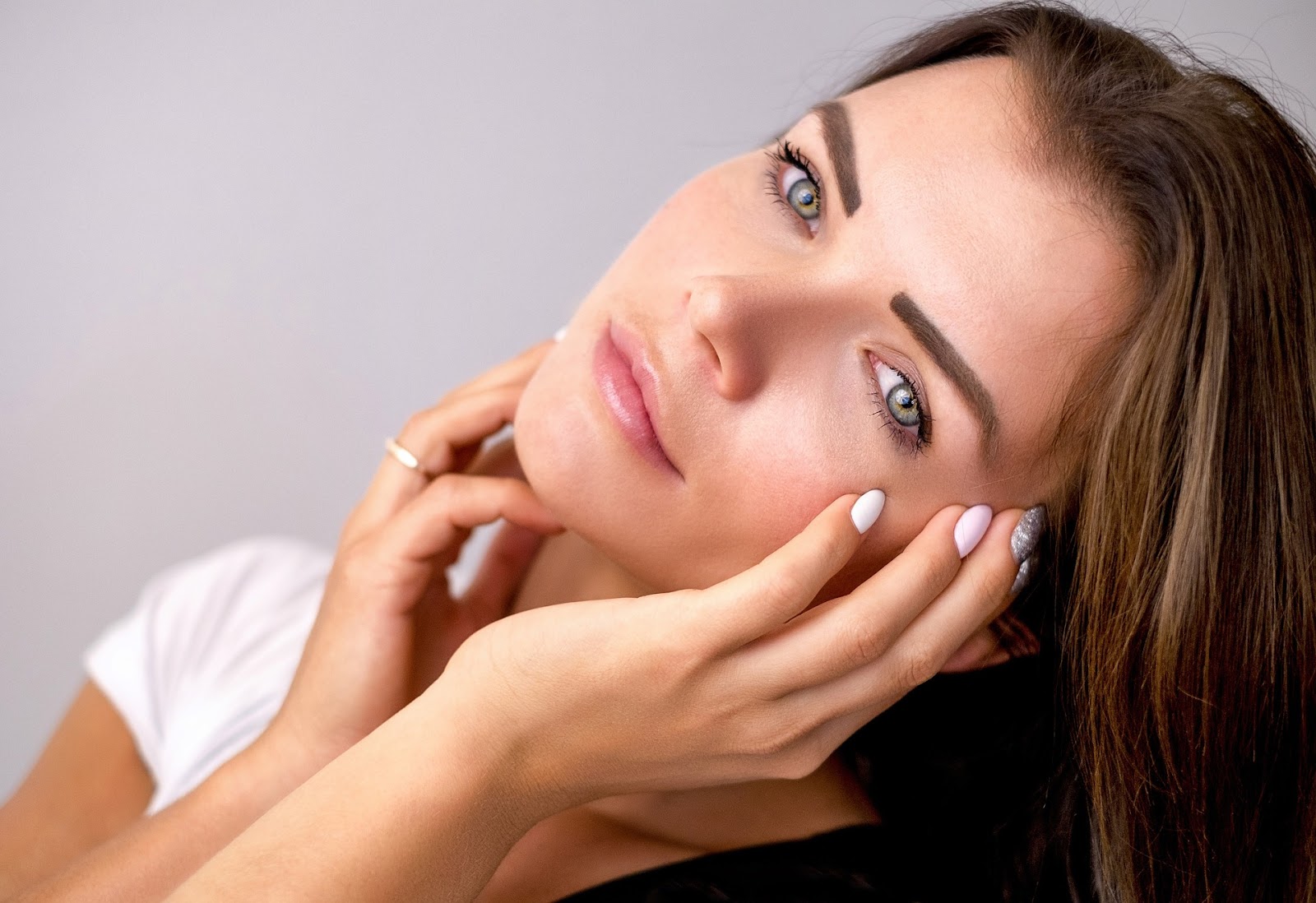There are many types of facial skin. Most often, each type of facial skin is determined by genetics, which has different characteristics. Nowadays, there are still many people who do not know what type of skin they have. As a result, they still choose to use skincare products, cleansing products, and cosmetics that are not suitable for their facial skin type. Generally, there are 5 types of facial skin types:
1.Oily skin
Skin problems are skin conditions that can be found a lot. There are many types of oily skin on the face. Some people may have oily skin only in the T-zone, or some people may have oily skin in specific areas such as the forehead, nose, chin, cheeks, or some may have oily skin all over the face and body.
The characteristics of oily skin that can be easily observed are oily skin quickly during the day, skin looks shiny, sometimes it may look greasy. Most people with oily skin often wear makeup rarely or lose makeup during the day due to hot weather and sweat. This makes it necessary to use oil absorbent paper to help remove oil during the day.
Normally, all humans have sebaceous glands under the skin that produce sebum, but for those with oily skin, one of the reasons is that the sebaceous glands produce too much sebum, causing sebum in the skin, which can lead to various skin problems such as clogged pores, clogged acne, and inflammatory acne.
How to care for oily skin
Although oily skin is mainly caused by genetics, which is difficult to prevent, you can alleviate symptoms and modify daily habits to reduce skin oiliness. For those with oily skin If your face is greasy during the day, makeup is not often applied, or you need to keep your face covered all day, you should follow the following:
1. Choose products that help control sebum on the face.
2. Wash your skin twice a day to prevent your face from drying out, as washing your face can reduce moisture. When the skin is not moisturized enough. The sebaceous glands produce oil to replace the lack of moisture, which makes the face greasy.
3. Face mask Masks can help control sebum, so choose a mask that contains clay, mectite, bentonite, honey, and oatmeal that has the properties of helping to control sebum on the skin, help cleanse the skin, and soothe the skin.
4. Use skincare or skincare products that contain oil-free and non-comedogenic moisturizers. When the skin is sufficiently hydrated, The sebum on the skin is also reduced, as the sebaceous glands do not need to produce oil to replace moisture.
5. Can use blotting paper It helps to absorb excess oil on the face during the day, but do not blot too often.
2. Dry skin
The appearance of dry skin can be observed from the feeling of dry and tight facial skin after washing your face, or the skin of the face is cracked and flaky. Rough skin: If the skin is very dry, it may be accompanied by itching. Usually, dry skin on the face is temporary or seasonal. Dry skin problems often occur on the face, arms, and legs.
The cause of dry skin is that the skin loses too much water. This causes the skin to lack moisture and dry skin from irritation from certain chemicals such as bleach or nickel, etc.
How to care for dry skin
For those who have very dry skin, it is recommended to consult a dermatologist to detect the cause and treat it in time. The skin can break off and bleed along the cracks. But for those with mild to moderate dry skin. You can follow the following tips to relieve symptoms and help your skin return to health:
1. Apply products or skins containing moisturizer immediately after showering.
2. Avoid using hot water to wash dry skin areas.
3. Avoid scrubbing or rubbing dry areas as scrubbing or rubbing can cause irritation and worsen skin conditions.
4. Choose a moisturizing cleanser or skincare product or a product that suits your skin type. If the skin is very dry, products containing petroleum, lactic acid, glycerin or shea butter can be used.
5. Avoid products containing perfumes as they can irritate the skin of the face.
6. Increase the humidity of the room or air by using a humidifier to help the skin of the face retain moisture at all times.
3. Combination skin
Combination skin is a common facial skin that can be found. The characteristics of combination skin can be observed, namely oily skin in some places and dry skin peeling and flaky in some places. The T-zone (forehead, nose, and chin) is more oily than other areas because the T-zone has a large number of sebaceous glands, and the areas where dry skin is usually located are the cheeks, jawline, and hairline.
The main cause of combination skin is genetics. If family members A father or mother with combination skin may also make you have combination skin. In addition, hormonal changes are another factor that causes combination skin, and there are other factors such as the environment, facial care products used, and certain lifestyle habits that may affect the health of the facial skin, making it a combination skin, such as using harsh products or containing sebum control ingredients that dry out the skin and cause the sebaceous glands to produce oil to replace the lost moisture.
The body produces oil when the skin is dry. It can cause clogging in the pores and cause acne. Whether it's blackheads, headless pimples, elephant head pimples, or pustular pimples. The cause is all oil blockage. Dead skin cells and bacteria
How to care for combination skin
How to take care of your face for people with combination skin may be a little more complicated than for those with dry or oily skin because you need to use 2 skincare products, for oily areas and dry skin areas. For oily areas, it is recommended to use light-textured products such as gels or serums, and for dry areas, heavier products such as creams can be used.
Choose products that are gentle and can moisturize dry areas during the day, such as mineral water spray, but be careful not to get into the T-zone area where the skin already has a lot of oil.
4. Sensitive skin
Sensitive Skin can be observed in red, flaky, pimples, and itching, where the skin will have an allergic reaction immediately after exposure or stimulation, such as exposure to strong winds or the use of inappropriate or non-standard facial products.
Sensitive skin is mainly caused by a weak skin barrier or a lack of ceramides, which are fatty acids that the body can naturally produce. It acts as a barrier for the epidermis, helping to retain moisture and help protect the skin from allergic reactions.
When the skin barrier is weakened, the skin is stimulated by external factors. It is susceptible to bacteria, dirt, chemicals, and weather, and can cause allergic reactions such as redness, bumps, and irritation.
How to care for sensitive skin
For those with sensitive skin The following instructions can be followed. To protect the skin of the face and reduce irritation, including:
1. Avoid scrubbing or rubbing the face area. It is recommended to use light stroking instead of scrubbing.
2. Avoid showering and cleansing your face with very hot water.
3. Use gentle and fragrance-free products. Alcohol, and parabens such as soap, shampoo, laundry detergent, and skincare.
4. Every time you try a new product. It is recommended to test on a small area of skin before actual use to prevent allergic reactions.
5. For those who want to use perfume, you can use essential oils instead of perfume.
People who have an allergic reaction to the product should immediately seek medical attention to determine the cause and treat it in time. It may cause the disease to worsen.
5. Normal skin
The characteristics of normal skin are small pores and smooth skin. The pinkish colour is not dull and is not sensitive to the external environment. However, there may be some acne, which is considered natural because acne can occur in anyone and all skin types, but normal skin is less likely to develop acne and skin problems than other skin types.
Normal skin is facial skin with a good balance between sebum and moisture within the standard standard. Normal skin is not too dry or greasy. Scientifically, it is called Eudermic instead of normal skin, which normal skin may have a little oiliness in the T-zone. The skin can turn into dry skin as collagen production in the body decreases with age.
How to care for normal skin
For normal skin, moisturizing products can be used to maintain facial skin balance, and products can be used to control the sebum of the skin during the day. However, products that are gentle on the skin should be used and should be avoided that contain substances that are harmful to the skin and cause blockages. Blockages in the pores are often accompanied by acne and dermatitis.





